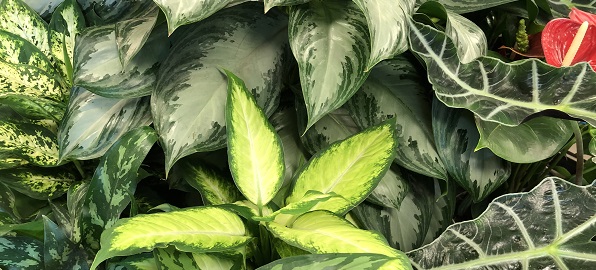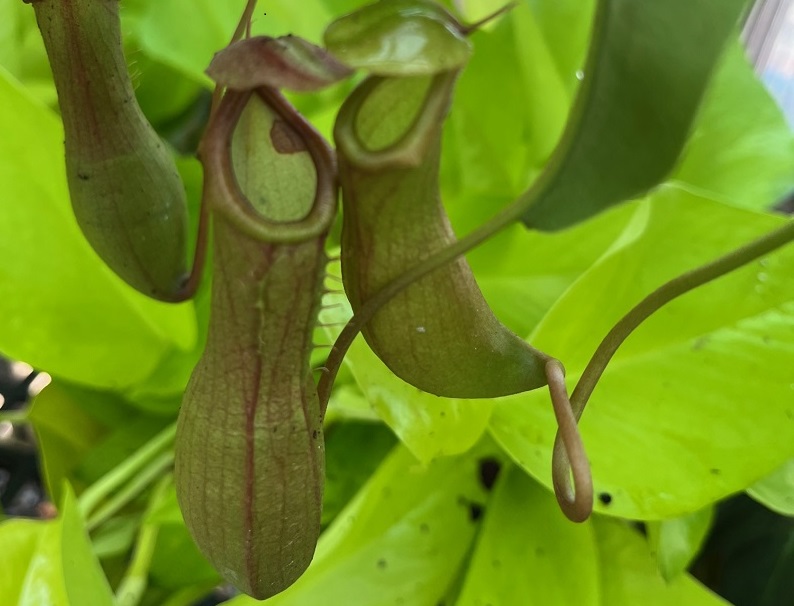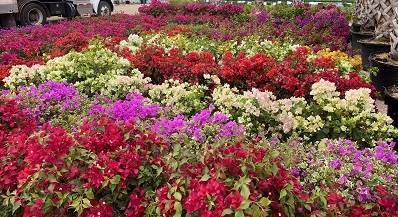Most houseplants are from tropical locales where cold temperatures are rare and temperatures average 72°F. Although they do well in our yards during the summer, they will need to be moved inside before temperatures reach the 40’s to 50’s at night.
Ideally, if your plants are in sun or part sun outside, such as Bougainvillea or Tropical Hibiscus, they would benefit from being moved to light shade for a week or so before transitioning them to the indoors. This will cut down on the stress that causes their leaves to yellow and drop when conditions change rapidly. But, if you are like me, the cold weather sneaks up on us and that transitioning is not possible. Leaves will drop, but with proper placement and care, new leaves will form, and the plant will recover.
*Do not locate your plants under a heat vent, as this will dry out the foliage and stress the plant.
Lighting: Try to locate the plant in the best light according to their needs. Plants that require high light should do well in a south-facing window. East and west-facing windows are also bright, but the north-facing windows are best for plants that do not require high light conditions. Plant lights may also be utilized to provide the needed light and should be set on a timer for 16 hours a day.
Watering: Your houseplants will require less frequent watering after being brought indoors, as the temperatures indoors will be more moderate. When you do water, be sure to water THOROUGHLY. Watch our VIDEO on how to properly water houseplants HERE.
Check for Pests: It is much easier to treat for pests while the plants are still outside. Check the tops and bottoms of leaves, the stems and leaf axils (where the leaf attaches to the stem) for signs of pests. Most soft-bodied pests may be treated with a Spinosad soap spray, covering the plant thoroughly. Don’t forget to check the soil for Fire Ants, which sometimes move to pots for more moisture. A thorough drench of Spinosad will rid the pot of ants.
Repot: If a plant has lost soil in the top of the pot, it is ok to add it back-just be sure not to add any soil above the original soil line. If you do add too much soil, it will rot the stems.
If a plant is obviously rootbound, it is best to repot it outside before bringing it in for the winter. Do not “overpot”. Make the jump in pot size no more than 6” larger. Watch our repotting VIDEO HERE.
Pruning: Remove dead leaves and branches before bringing the plant inside. If the plant is too large to bring inside, as in a large Bougainvillea, it is ok to prune it back to a reasonable size. Just remember that with less leaves it will require less frequent watering.
Fertilizing: It is not necessary to fertilize houseplants in the winter. We fertilize during the growing season which is generally from March to October.
Humidity: Plants which require high humidity may be placed on a shallow tray filled with pebbles and water. The bottom of the pots should be ABOVE the water. As the water evaporates it will raise the humidity around the plant. Maidenhair ferns will especially benefit from this. Be aware that heat vents blowing on plants will dry them out.
Some tropical plants such as Bougainvillea may be overwintered in a garage that will not freeze. They may be pruned to accommodate the space, and watering will be on an as-needed basis. The cooler it is, the less often you will water. In a mild winter, I will bring my citrus and bougainvillea inside the garage for a hard freeze, or just cover with frost cloth for a light freeze or frost. When the freeze is over, I move them back out or uncover them. They do quite well this way in mild winters if you are able to move them easily. This is one reason why we recommend planting them in a plastic nursery pot and setting it down into the decorative pot. It is MUCH easier to move plants in the lighter pots!
Tropical Hibiscus is sensitive to temperatures in the 50’s, so moving it to a warmer location for the winter is recommended.
Sweet Potato Vines will go dormant at 40°F and may be overwintered in their pots in the garage. Bring them out in the spring and begin watering when temperatures are warm again.





Leave A Comment